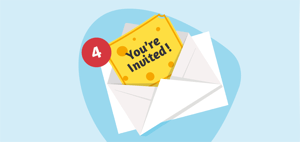This is the final blog of the Insight Session Series: Create the perfect communication flow for your event. In our previous blog we showed the importance of email settings. The following and final blog is how to avoid spam, and increase the deliverability of your event email campaigns.
1. Email deliverability
The mail settings consist of your database, salutations, reply-to address and subject lines. These settings may look pretty standard, but you will be surprised by the effect of the right subject line on your open rate. And preparing your database upfront can save you a lot of time. These details make all the difference in your total event email campaign. Here is how you set them right:
Mail applications, also called Email Service Providers (ESP) will give you feedback and results about your mailing. One of the indicators is ‘deliverability’. Let’s explain the concept: If a email invitation has been delivered, it means the email address is correct and the mail server of the recipient accepted it. The deliverability percentage shows to what extent your address list is up-to-date. In other words: the more accurate your database is, the higher the deliverability rate.
When something is wrong with the address or recipients mail server settings, your email will be bounced:
2. Hard and soft bounces
Bounces occur when an event email cannot be delivered to an email address. When an email bounces, it is classified as either a soft or a hard bounce.
A hard bounce indicates a permanent reason an email cannot be delivered. The most common reasons an email is bounced are find below:
- Recipient email address does not exist or contains an error.
- Domain name does not exist or contains an error.
- Recipient email server has completely blocked delivery (or blocked sender).
A soft bounce is a temporary delivery issue. Often this occurs because the inbox of the recipient is full. Both hard and soft bounces can be a reason for you to inform the recipient (by phone, or otherwise). This offers you a great opportunity to inform them about your event.
3. Spam / inbox
There are multiple variables and settings of the mail server that determine whether the event email is delivered to the inbox of the recipient. Sometimes it ends up in the spam folder. Each mail server has their own indicators for marking email as spam. These settings differ per recipient and they are never exposed to the public. However, there are some general rules like avoid words as "Gamble, Win, Prices, Sale, Discount etc.". Same goes for characters such as: !@**^%!) - try to avoid them as much as possible.
4. Open and click through rates
Open and click through rates (CTR) give you a good indication of how your mailings perform. A high open rate, usually indicates your subject interests your audience. A high click rate means your recipients respond well to the content of the mailing: the call-to-action (CTA). In case of event communication, it means the register or cancel link is well placed.
The average open rate of the emails sent by Momice clients is 51,62% (based on op 2,5 million emails sent from the software). The average click through rate for these mailings comes down to 26,85% (every clickable link is included).
These numbers are just an indication: many factors influence the success of your mailings. The percentage for your mailings can differ, based on the quality of your invitee list, the design of your email and the moment your mailing is sent. Make sure you plan your communication flow carefully - from the save-the-date until the survey after the event. Structured and effective communication with your audience results in more registrations and less no-shows for your event.
Conclusion
Sending effective email invitations is a process of trial & error, testing and analysing. So experiment with different settings, layout, and calls-to-action (CTA) to learn what works best for your recipients. When you have a better feeling with your target group, start planning your mailings. Carefully prepare and schedule the complete flow, from the very first event email. It will result in organised, time efficient and clear event communication for your recipients. This in the end will contribute to an accurate list of attendees and a lower no-show rate for your event.

